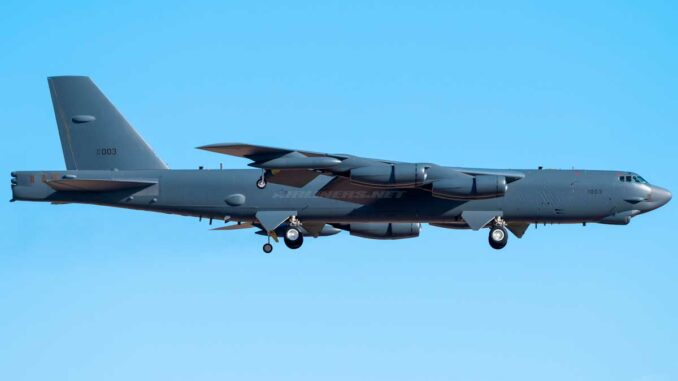
Two American B-52s intercepted by Russian fighters near Kaliningrad during an exercise involving Finland and Sweden. Analysis of the stakes.
Last Monday, two American B-52H strategic bombers were intercepted by Russian Su-27 fighters near Kaliningrad, in the Baltic Sea. The interception, described as professional by US officials, took place in the context of a joint military exercise between the USA, Finland and Sweden. The event comes at a time when tensions remain high between Russia and the United States due to the conflict in Ukraine. This type of interaction highlights the strategic stakes in the region and Finland’s growing importance within NATO.

The geopolitical context of the interception
The interception of the two B-52Hs took place near Kaliningrad, a strategic Russian enclave located between Lithuania and Poland. This region is particularly sensitive, as it is home to major Russian military installations, including S-400 air defense systems and Iskander ballistic capabilities. The B-52Hs were taking part in training as part of the Bomber Task Force mission, aimed at strengthening cooperation between NATO’s European allies.
The deployment of B-52s in Europe, which began in November, reflects the United States’ commitment to its allies in the face of rising tensions. These bombers, capable of carrying both conventional and nuclear weapons, symbolize American strategic deterrence. Their presence in the region is a clear signal to Moscow of the ability of allied forces to operate in contested areas.
Military integration between NATO forces
During the exercise, dubbed Apex Jet, the B-52Hs worked with Finnish F/A-18C fighters and Swedish JAS 39 Gripens. The training marks an important step in the military integration of the new NATO members. Finland, which joins the alliance in 2023, is playing a growing role in the defense of Europe’s northern flank.
The B-52s also carried out simulated weapons drops over Finland. These maneuvers illustrate NATO’s objective of strengthening its members’ capabilities in the face of Russian threats. According to NATO data, military integration is crucial, as the Nordic countries cover a strategic area of 1,300 kilometers of border with Russia, increasing the complexity of defense scenarios.
The technological and strategic challenges of the B-52h
The B-52H Stratofortresses, in service since the 1950s, have been modernized to remain at the heart of American strategic deterrence. Capable of flying 14,000 kilometers without refueling, these bombers can carry a 31.5-ton payload, including conventional and nuclear munitions. Their flexibility makes them invaluable tools for projecting American power.
Their presence in Europe also underlines the role of modern technology in American strategy. The bombers are equipped with advanced electronic warfare systems, enabling them to operate in highly contested environments. These capabilities are particularly relevant in the Baltic region, where Russian forces have sophisticated jamming and air defense capabilities.

Implications for regional security
The Russian Su-27 interception, although described as “professional”, illustrates the ongoing tensions in the Baltic Sea. This area is a major point of friction between NATO and Russia, due to the strategic interests it represents. According to experts, such interactions could become more frequent as NATO steps up its activities in the region.
Military exercises such as Apex Jet strengthen coordination between allies, but also increase the risk of incidents. Interceptions of this kind require precise communication to avoid escalation. By 2023, according to a SIPRI report, military activities in the Baltic region had increased by 35%, reflecting growing militarization.
The impact of the Ukrainian conflict on NATO-Russia relations
The global geopolitical context amplifies the importance of this event. Since the start of the conflict in Ukraine in 2022, relations between NATO and Russia have deteriorated. The United States, Ukraine’s main military ally, is stepping up deliveries of modern weapons, such as ATACMS systems. These long-range missiles have recently been used by Ukrainian forces to strike targets on Russian territory.
Russia, in response, is stepping up its demonstrations of force, such as the recent launch of an experimental missile towards Dnipro. Although unarmed, this act symbolizes Moscow’s desire to maintain psychological pressure. These actions show that the confrontation is not limited to the Ukrainian theater, but also extends to strategic regions such as the Baltic.
War Wings Daily is an independant magazine.